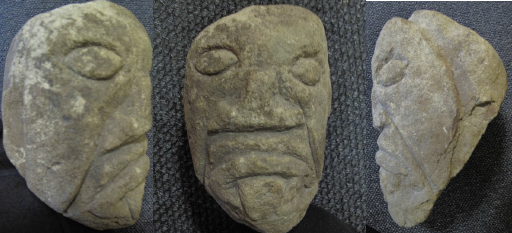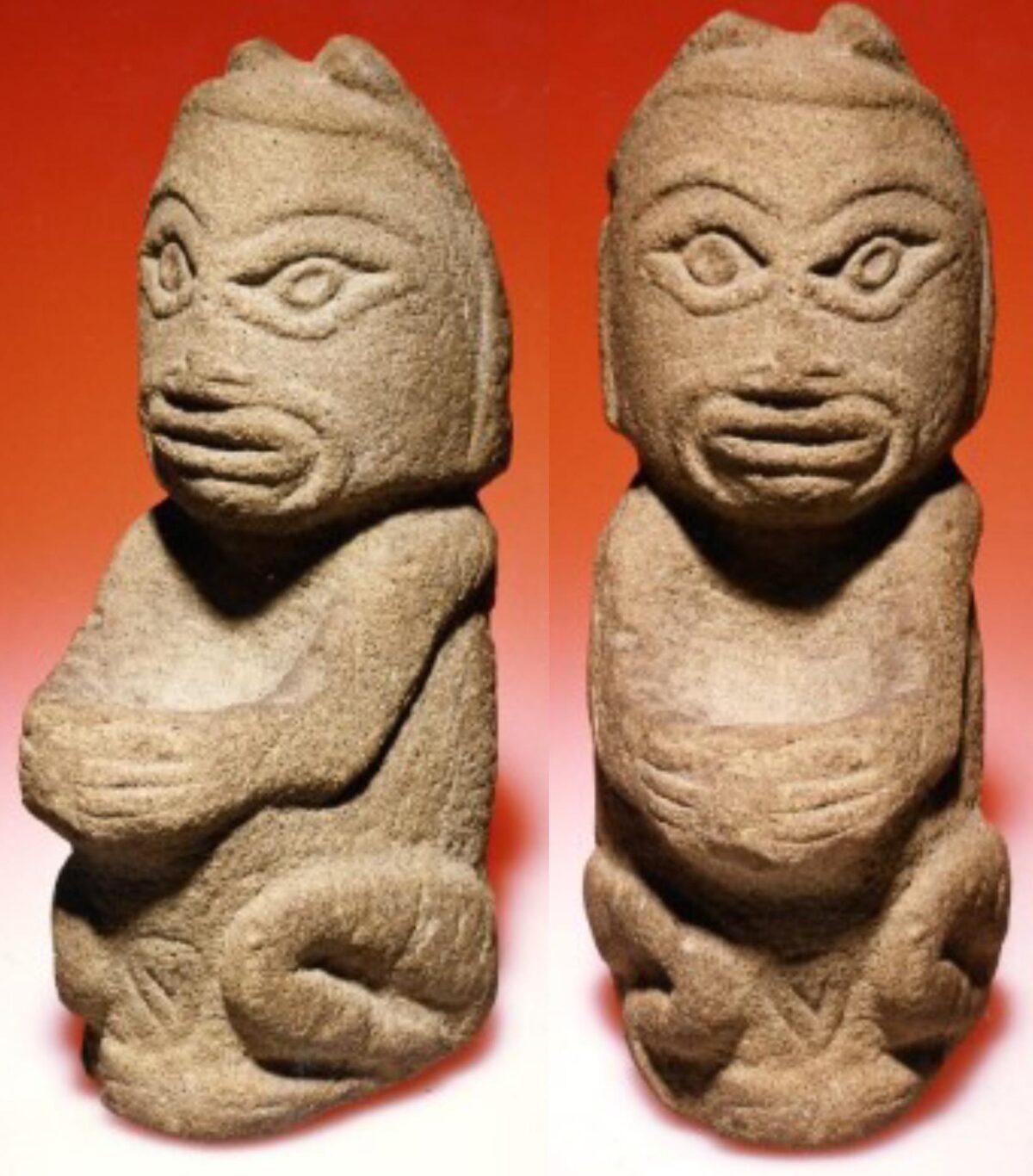by Grant Keddie
Preface for Part 2.
Part 2, includes eight seated human figure bowls from the Saanich Peninsula north of Victoria on Vancouver Island. There are a few others from private collections believed to be from this general region that are not included here. The north Saanich Peninsula region, especially the area around Tsehum Harbour on the east side, was an important cultural centre in the past. There are several large archaeological shellmidden sites in Tsehum Harbour on the north side of the town of Sidney and a large shellmidden just to the south along Bazan Bay. Tsehum Harbour is an area protected from the weather as well as a location providing access to a diversity of local environments. At least one of these sites, designated DeRt-1, has radiocarbon dates from the lower deposits with a time range between 3980 cal BP and 3550 cal BP and can be considered as a more permanent winter village or year-round site location based on the fact that it has deep buried deposits and a diverse variety of faunal remains and artifacts.
“Sddlnewala”. The Mount Newton Bowl.
This stone figure is now in the possession of the W̱SÁNEĆ people.
Overview
The stone figure called the “Mount Newton Bowl”, has been given the SENĆOŦEN name “Sddlnewala”. It is a squatting human figure with a bowl formed between the person’s out-stretched arms. It is made of sandstone and is 29cm (11 ½ inches) high. It has been referred to as the “Mount Newton Bowl” as it was found in the general area of Mount Newton. It was not found on the Mountain, but (based on information from the 1950s) in a low area in the 1100 block of Mount Newton Cross-road.
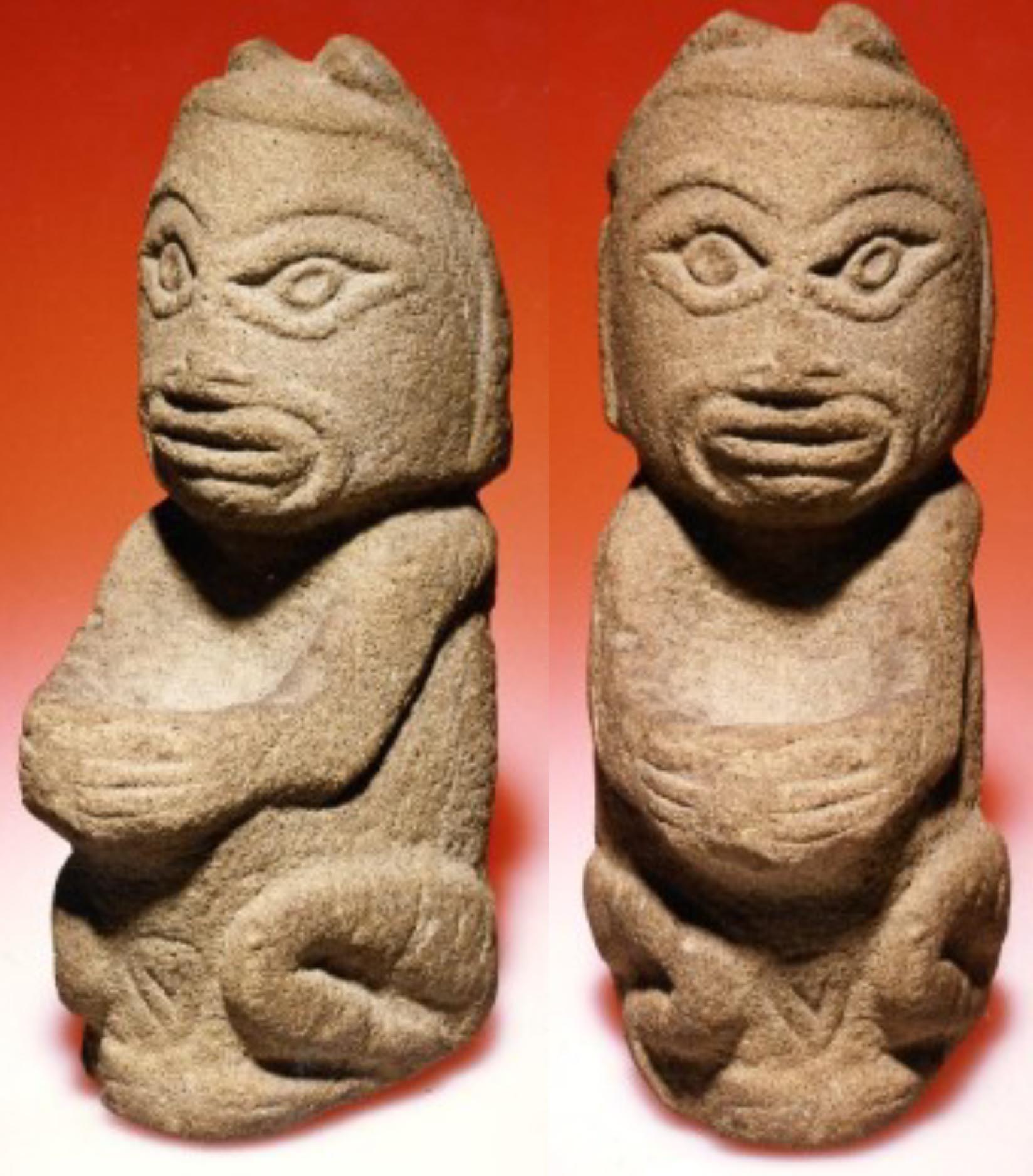
Find location and numbers given.
The description of the location provided in the 1950s, states that the stone figure was: “Found about 50 years ago, plowed out 60 ft above spring, ¼ mile in from Saanich Inlet on Mt Newton Crossroad”. It was then owned by Mrs. H. S. Hughes of “Bannockburn [farm]. Saanichton P.O.”. In the 1950s Mrs. Hughes lived at “1189 Newton Road”.
The seated figure bowl was not from a recorded archaeological site and was therefore later given an approximate area number under the Borden archaeological numbering system – DdRu-Y:118 (The “Y” referring to the general area with the DdRu Borden unit). In 2009, D’Ann Owens of Millenium Research gave the location an archaeological site number: DdRu-140.
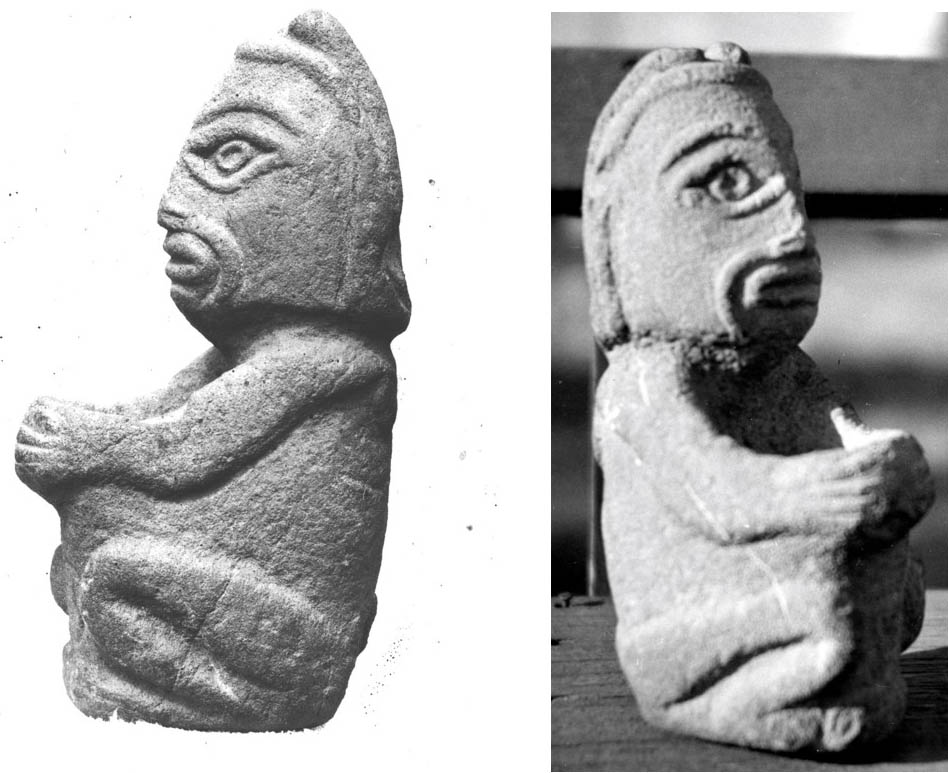
The Legal Controversy
In 1993, the bowl had been purchased from the family that found it and was in the possession of collections dealer Howard Roloff. Roloff wanted to apply for an export permit to sell the bowl to a U.S. buyer. He formally applied to the Canadian Cultural Property Review Board on April 27, 1993. The Royal B.C. Museum, acted as the “expert examiner” in British Columbia, regarding such applications when they involved archaeological or ethnographic artifacts.
The Human History Division of the Museum, reviewed this application April 28-29, 1993, and recommended the application be denied. The manager, Dr. Gay Frederick in her letter of refusal stated in part: “My refusal is based on consideration that this object is of outstanding significance to Canada by reason of its close association with Canadian (First Nation) history, its importance for scientific research and my consideration that its loss to Canada would significantly diminish the national heritage”.
Simon Fraser Department of Archaeology contacted Brian Apland, the director of the Archaeology Branch, on May 14, 1993, and asked if they could stop the export of the stone bowl. Apland contacted the Federal Archaeology office and had discussions with the Cultural Property Export office and B.C. government lawyers. There was at the time, no Federal legal means to stop the export, only to delay it.

Apland prepared a letter for the Provincial Minister to the federal Minister of communications indicating their considerable concern over the ease at which significant artifacts can be exported from the country and demanded the Cultural Property Export, Impost Act be amended to protect archaeological artifacts.
The Canadian Cultural Property Export Review Board met June 10, 1993 and denied the appeal of Howard Roloff regarding the earlier denial of his application. The latter started a delay period of three months, which would end on September 9, 1993. After this, the artifact could be exported if a Canadian buyer could not be found.
The Archaeology Branch wished to proceed to have the artifact designated a “Provincial Heritage Object”, which could prevent the artifact from leaving the province, without a permit from the Minister responsible for the act. However, the legal opinion was that the Provincial legislation would be ineffective in prohibiting the export because the federal legislation had paramountcy over the Provincial law. The alternative at the time was to purchase the artifact.
Dr. Barbara Winter of Simon Fraser University’s Museum of Archaeology and Ethnology heard about the bowl’s imminent export through the Cultural Property notices in July of 1993. Winter was quoted at the time: “Our interest in this is solely to prevent its export. We are fundamentally opposed to the purchase of artifacts, however, the danger of export in this case was such that we felt we have to do this”.
Brian Apland of the Provincial Archaeology Branch and Barbara Winter, then worked with Diana Henry and Gabe Bartelman of the Saanich Native Heritage Society to negotiate a way to keep the Bowl from going out of the Country.
On October 26, 1993 the Times-Colonist reported:
“Federal grant keeps ancient local artifact out of U.S. A federal grant of almost $40,000 to Simon Fraser University will save an ancient Indian artifact, found in Central Saanich, from being exported to the U.S.”.
An agreement was made between the Saanich Native Heritage Society, SFU and the federal government that the original bowl, while being owned by the Saanich Native Heritage Society, will be housed at SFU under a custodial agreement. At this time a name was given to the bowl – “Sddlnewala”. It was catalogued at the SFU Museum as 1993.22.1.
See the following articles:
1993. Pamela Bishop. Can Indian art lovers meet deadline? That’s the $60,000 question. Times Colonist September 8, D10.
1994. SFU Media & Public Relations. Bowl ‘Purchase’ Aimed at Changing Heritage Laws. The Midden. Publication of the Archaeological Society of B.C., 25:5:1,.
1994. Barbara Winter, Brian Apland and Diana Henry. At the Crossroads. Exporting Heritage, The Midden. Publication of the Archaeological Society of B.C., 26:1:7-8.
1995. New Futures for the Past, Co-operation between First Nations and Museums in Canada. UBC Law Review Special Issue, p. 29-36.
Casts Made
During the negotiation period the Royal B.C. Museum agreed to make three copies of the original stone bowl. The first one (DdRu-Y:118; cast No. 1) was transferred to the Saanich Native Heritage Society in September of 1993. The RBCM retained two copies: DdRu-Y:18 (cast No. 2 and 3).
History of Documentation
1905. Dr. Charles Newcombe took photographs of the Bowl which were eventually donated to the (then) Provincial Museum. The original negatives are catalogued as RBCM PN738a and PN738b (later PN7580). These are listed in the Newcombe Register No.1, under E.C. IX/82 as: “Carved Stone S. Saanich 1905” – a later pencil note has added “Thompson”. An original print made from PN738a has “S. Saanich. 1905” written on the front and “At Frasers Farm S. Saanich June 01” written on the back.
Two glass lantern slides were made from the negatives by Harlan I. Smith, then of the American Museum of natural History, and copies sent to Newcombe. On one of these – labeled “E.C. 75” there is a paper label on which is written “Saanich – (Thompson’s)” and a small round sticker “Thompson’s”. The second glass lantern slide (same view – “137” on a paper sticker) is labeled “Saanich Thompson’s”. It has Harlan I. Smith stamped on it with “2102” written after the name. The Thompson farm on which the bowl was found is called Bannockburn.
1907. A drawing of the human figure bowl appeared as Figure 183d, in Harlan I. Smith’s publication: Archaeology of The Gulf of Georgia and Puget Sound [Part VI. In: Memoirs of the American Museum of Natural History, Volume IV., New York, G.E.Stechert & Co. 1907]. The caption on page 421 reads – under the title “Carved Stone Dishes” – “Made of gritstone, from Saanich Peninsula (from a photograph taken by Dr. C. F. Newcombe), 1/3 nat. size”.
1923. A drawing of the human figure bowl appeared as Plate XVI, Figure 2. In Harlan I. Smith’s publication, An Album of Prehistoric Art, In: Canada. Department of Mines, Victoria Memorial Museum, Bulletin No. 37, Anthropological Series No. 8, June 1, 1923, Ottawa. The caption on page 52 reads: “Carved dish made of gritstone. From Saanich peninsula, southeastern Vancouver Island, B.C.; approximately ½ natural size. After Figure 183d, Smith, Gulf of Georgia, 1907, from a photograph by Dr. C. F. Newcombe.”
1950s. Photographs were taken by Robert H. Nichols in the 1950s. RBCM. PN7577; PN7578; PN7580. On a piece of paper Nichols wrote: “Mrs. H S Hughes” – “Bannockburn” – “aunt of Mr. & Mrs. Nimmo.” – “Bannockburn Saanichton P.O.” – “Found about 50 years ago, plowed out 60 ft above spring, ¼ mile in from Saanich Inlet on Mt Newton Crossroad. 11 ½” high, 6” wide. Sandstone.” – R.H. Nichols 325 Menzies”.
Nichols later wrote on the back of photograph PN7577: “Found by Mrs. H.S. Hughes [50 years ago] of Saanich, V.I. Indians refused to look at this, pronounced it “evil”. This figure was unknown to Museum until a few week[s] ago”.
Nichols was not aware that Charles Newcombe had taken photographs of the bowl. Robert Nichols was not an academic, but was employed on a part time basis by the Provincial Museum in the late 1950s until about 1969 to purchase historic and ethnological artifacts for the museum.
1956. In Wilson Duff’s publication Prehistoric Stone Sculpture of the Fraser River and Gulf of George (In: Anthropology in British Columbia, No. 5, pp. 7-155, British Columbia Provincial Museum, Department of Education, Victoria, 1956), he describes this bowl (his No.38 on page 36-37) and seems to use the provenience information provided by Nichols:
“This figure was ploughed up in a field on rising ground about one-quarter mile from Saanich Inlet on Mount Newton Cross-road, well over 50 years ago. It belongs to Mrs. H. S. Hughes, of Saanichton”. On page 141 there is a drawing (Plate 14c) of the bowl which is “From a photograph by R.H. Nichols”.
Wilson Duff’s Description
“The stone figure (Cast. RBCM DdRu-Y:118) is a squatting human with a bowl (inside area about 5.5cm by 6cm) formed between the persons out-stretched arms. The fingers of each hand are spread out toward each other with a gap of 12mm between them. The bowl is made of sandstone and has a maximum height of 29cm and maximum width of 11.5cm.
The back of the figure below the grooved line of the neck has no features except for shoulder blades. The lower portion of the figure shows the bent legs extending around the bowl with the feet nearly meeting at the bottom of the front. Between the knees is a vulva-like figure which could be interpreted to indicate the figure represents a female.
Around the sides and top of the head is a raised area that likely represents the person’s hair. On both sides of the back of the head are elongate figures which form a curl just above the neck and extend up to and over the top of the head forming a bulbous end. Portions of each of the bulbous ends have been broken or eroded off. These elongate figures likely represent snakes. A number of other human seated figures with snakes coming off both sides of their head or snakes forming their spine have been found on the southern coast.
The face of the figure shows a prominent eye brow ridge that curves across the eyes and joins at the middle. The large eyes are outlined by raised oval converging lines (8cm from side to side compared to the total head width of 10.3cmm across this area). Inside these raised lines is a flat surface with raised line circles representing the eyes and the holes inside these representing the pupils. The nose is an extension in line with the forehead that extends out only slightly before it ends above the lip area.
Small nostrils extend to each side with a shallow groove through their middle. The nostril area is part of a prominent raised line that extends above and around the mouth area to the chin. The mouth is a distinct raised oval line with areas of the face around it and a slight chin below. This latter region may represent the lower portions of an inner face protruding out of the edge of a covering or mask – the bottom of which is represented by the raised line surrounding the mouth region.
Speculation on the features and age of the figure.
This design is reminiscent of figures found in Central American and other parts of the world that represent a person wearing an animal or human skin mask. The prominent eye design is seen on other southern coast figures that are also associated with snake motifs. Possibly the figure was used in a ritual that involved some aspect of a relationship between the person figured and snakes. Other figures, including a rattlesnake bowl found on the Saanich peninsula, suggest there were once ritual activities that involved snakes. These activities and any oral traditions about them did not extend into recent times.
Most stone bowls of this type have not been found in datable archaeological contexts. Some are associated with sites that have extensive deposits dating to around the first few centuries A.D. or have characteristics similar to other kinds of artifacts dated to that time period. It has therefore been assumed that these kinds of bowls date to that time period. We could suggest a tentative date range of between about 1500 and 2000 years ago, but this can only be considered an education guess at this time. There is more information that needs to be added to the above and further examination on the history of the various properties mentioned in regard to where the bowl was found”.
Patricia Bay. Martin Bowl 1
This bowl is from the Patricia Bay area of the Saanich Peninsula. The RBCM has two casts of this bowl (old number 2875). Its present location is unknown.
This bowl in a 1907 publication of Harlan I. Smith, is drawn from a cast. The RBCM did not get a cast until 1915. A drawing with caption is seen in the Provincial Museum annual report of 1915, Pl II. Fig. 1. The caption reads: “Carved sandstone medicine-dish property of the Hon, Mr. Justice Martin. Museum Cast. Catalogue No. 2875.”
Harlan Smith Description
Harlan I. Smith describes this bowl in his unpublished notes:
“Carving is grit stone, a seated man, ‘lap’ forming a kind of bowl, upper edges of which are formed by the arms, hands meeting in front. End of nose and lope of left ear missing. Right arm perforated, left arm broken. Use unknown by eldest inhabitants. Resembles specimens in the Provincial Museum, Victoria and owned by the Hon. Justice Martin, Victoria B. C. Found in old shell mound on west side of Saanich peninsula, near the north end, near Union Bay [now Patricia Bay] of chart. Saanich, near Victoria, Vancouver Island, B.C. (Saanich, Salishan) Collected by C. . Newcombe, on Field Museum Expedition, 1902. Cat. No. 79382”.
The sale of the bowl is likely one of the items referred to in the Journal of Science in 1926 (Science, vol. LXIV, No.1653, p. 222). It is from the collection of John Newbegging who lived in North Saanich:
“The valuable collection of Vancouver Island Indian curios from the Patricia Bay Reserve has been sold to the American Museum of Natural History by Mrs. John Newbigging, of New York, owner of the property. The collection includes handsomely carved idols, axe handles, large numbers of spoons, bone needles and arrowheads”.
A letter from anthropologist, Dr. Erna Gunther inquiring about the bowl was sent, Dec. 6, 1935, to the Provincial Museum Director, Francis Kermode: “I have looked up the date on No. 2875 which is as follows – Carved stone medicine dish, sandstone. Cast of Original owned by the Hon. Mr. Justice Martin, 1916.”
The director replied: “As far as I know this specimen was sold by the Hon. Mr. Justice Martin to the late Dr. Goddard of the American Museum of Natural History, New York. The specimen that you were examining is only a plaster cast which I made of it many years ago. If you should desire a specimen some time when you are over here, I would be only too pleased to give you one, as I have several casts yet in storage.”
Collector, Frederick Docksteader, entered data on the caste, AMNH Cast Cat. No. 5/586, suggesting that the original bowl was “Found in shell heap 5’ below surface in roots of tree, June 1913”, which resulted in a suggestion that it was from the Vancouver area Eburne site, DhRs-1. The latter is clearly wrong.
Wilson Duff Description
Wilson Duff (1956:39) illustrates, as figure 2, the image of his bowl No. 44. This is the image that was published in 1916, in the Provincial Museum Annual Report for the year 1915. Duff did not have access to the Harlan Smith notes at this time. Duff writes as follows:
“Provenience – There is no clear data on this figure, but W. A. Newcombe [William Newcombe the son of Charles Newcombe] recollects that it came from the Fraser Valley. Cast was made for the Provincial Museum in 1916 (2875) at which time the bowl was owned by the Honourable Mr. Justice Martin, of Victoria. Its present whereabouts are unknown. Description- (from cast). The figure is of sandstone, and is the largest of all figures of this type. 21 inches high by 10 inches wide. It shows a seated human figure holding a bowl. There are few details shown, as all the shaping was done by pecking.
The head is 9 inches high. As usual the face is framed by a headdress, which projects over the forehead and down the sides to the jaw line, and merges upward into a large (broken) conical top knot. The head-gear resembles a peeked hood. The eyes and round projections left in relief by pecked depressions around them. Arched eyebrows meet in the centre and join the bridge of the nose which extends downward, then broadens out to form the flat nose. Lips stand in relief as a flat oval. The chin is somewhat prominent. The back of the head is smooth.
The arms and legs extend around the carving in the form of two broad rings. The arms start behind the shoulders with well-defined shoulder blades and extend almost horizontally around the small shallow bowl, meeting in the front. The back is plain, and expanded at the shoulders and pelvis. The base is flat”.
Duff is basing the provenience of this bowl on the bases that William Newcomb, (who worked at the Provincial Museum —) “recollects that it came from the Fraser Valley”. Duff worked at the Provincial Museum in 1950-1960. Williiam with his father Charles Newcombe had one of the largest collections of both ethnographic and archaeological artifacts that were donated to the Museum after William died in 1960.

Tsehum Harbour Bowl. (Martin Bowl 2)
Now in the Museum of the American Indian as number 2502. It is from an archaeological site, in Tsehum Harbour, north of Sidney on Vancouver Island. It most likely is from the sites DeRu-1 or DeRu-4.
Harlan I. Smith Involment
This stone figure (figure 5) is from the John Newbegging collection, obtained in North Saanich. Harlan I. Smith was aware that John Newbigging’s collection was from North Saanich, yet in his caption for Fig. 184a, Smith (1907:422), comments that it was: “Probably from the Fraser River Delta (Collection of Hon. Justice Martin, Victoria, B.C. drawn from cast 116/37. From Road Cut in shell-heap near North Saanich (Newbegging collection, from a drawing by Miss E. H. Woods)”. Smith repeats this mistake about the bowl’s provenience being from the Fraser River, in his 1923 publication.
Smith (1907:330) notes the provenience of the bowl: “There is a shell-heap of considerable extent and height on the peninsula between North Saanich Bay [Tsehum Harbour and previously Shoal Harbour] and Canoe Pass [east of Curteis Point]. This heap extends across the base of the small point [Mill Point] on the western side of this peninsula, [Archaeological site DdRu-1] and along the beach some distance northward [Blue Heron Basin Archaeological sites DdRu-4/5 and 6]. On the little point [Nymph Point]were a number of cairns which were explored by us in 1898. Following this beach northward, another shell-heap is found, extending along the shore on the northern side of the small arm of the sea which makes in here, and which ends toward the southwest. This heap is not far from the east-and -west road at this point. Most of Mr. J. Newbigging ‘s collection was found in cutting this road”.
The sale of the bowl is likely one of the items referred to in the Journal of Science in 1926 (Science, vol. LXIV, No.1653, p. 222), but not one of those from Patricia Bay.
“The valuable collection of Vancouver Island Indian curios from the Patricia Bay Reserve has been sold to the American Museum of Natural History by Mrs. John Newbigging, of New York, owner of the property. The collection includes handsomely carved idols, axe handles, large numbers of spoons, bone needles and arrowheads”.
Wilson Duff Description
Duff (1956:140), records this figure as his #45. His photo caption reads: ” “No. 45,of uncertain provenience. (After Smith, 1907, Fig. 184a, corrected)”. Duff repeats Smith mistake and records his figure No. 45 as :
“The Marin Bowl No. 2 (see Pl. 13b, also Smith 1907, Fig. 184a; Smith 1923, Pl. XVII, Fig. 2).
Provenience. – Like, number 44, this carving was in the collection of the Honourable Justice Matin, of Victoria, but its present whereabouts are unknown. A few museums have casts. According to Smith, this figure was “probably from the Fraser River Delta” (loc. Cit.).
Description –(Based on examination of cast in American Museum of Natural History). The figure is of soapstone, and the 5 ½ inches high and 4 inches front to back. It depicts a seated human figure holding a bowl, on front of which is an animal-like face.
The face looks slightly upward. The brow line is carried right around the side of the face to the mouth, which is protruded and rounded. The eyes are round with lenticular eyes, and nose flat with wide prominent nostrils. On top pf the head is a prominent top knot.
The arms extend downward from the shoulders and curve slightly to grasp the sides of the bowl. They are unique in being represented as snakes (or as wearing snake skin sleeves). The snakes head, with eyes, nostrils, and mouth, is marked plainly on the wrist, ad cross-hatched lines, along the arm depict the scale patterns on its back. Fingers are also shown on each hand. No legs, back-bone, or ribs are portrayed.
The bowl projects far forward of the figure, and on its front end is an animal’s head. This has large round eyes, a projecting snout, and ears. Just behind the head is a paw or flipper. The animal might be meant as a seal or possibly a bear.”.

The Tsehum (Shoal) Harbour Bowl
This stone bowl (Figure 6 & 7) is now in the Seattle Art Museum. Catalogue number 83.223. It is from the west shore of Tsehum Harbour (Shoal Harbor), North Saanich, Vancouver Island. It is likely this bowl was from one of the known Tsehum Harbour shellmidden sites that were cut through during early road construction projects. Soapstone, 14 3/4 x 4 5/16 x 7 5/16 in. (37.5 x 11 x 18.5 cm),
Wilson Duff Description
Wilson Duff has this bowl in his 1975 publication as No. 34. He provides a detailed description earlier (1956:34-35): “Provenience. – “Found in the raising bank about 100 feet west and a few feet above the shore of Shoal Harbour, North Saanich, on the property of Alan Defoe [In north Saanich. He later lived at 620 Rockland Street], this figure is now in the possession of Mrs. J.S. Clements of Victoria. The location is less than 200 yards south of a large shell mound, which is probably one of the North Saanich middens examined by Harlan I. Smith (Smith 1907. P. 330). The figure was at least 3 feet below the surface, but may have been disturbed previously by early road building.” “Provenience. – The figure is of soapstone (now painted with Masonite sealer), and is unusually large and narrow – 14 inches high, 8inches front to back, and 4 ½ inches wide. It depicts a human figure with a complex head-dress. Seated, holding a bowl which has a face on the front. It is shaped by pecking and grinding, and has an unusual amount of incised detail.
The face looks up, chin protruding. The brow is a distinct ridge framing the top and sides of the face, square across the bridge of the nose, then curving up over the eyes, back and to the ear level, where the ridge is narrower and higher depicting ears. The lower parts of the ears curve forward and merge into a strong jaw line.
The eyes are very large and round. They protrude somewhat and are outlined by deep incised lines and have definite incised corners. The nose is prominent but fairly flat, the alae indicated by incising. The mouth is shaped in a wide grin. Eight teeth are clearly depicted by incising, raises lips frame the mouth, and deep crescent shaped furrows in the cheeks around each end of the mouth heighten the expression of the grin.
The neck is a distinct unit separating the head from the chest and shoulders. The arms start with shoulder-blades at the shoulders and extend downward and forward part way along the sides (not rim) of the bowl, ending in flared incised fingers. The legs also extend along the sides of the bowl in relief, slightly bent, but petering out just below the knees. Strangely they are shows as extension of the head-dress, and are decorated with drilled depressions. The bowl itself in smoothly excavated in the lap and chest of the figure and is 3 inches in diameter and 1 ½ inches deep.
The head-dress in most unusual and very large. It extends as a separate unit all the way down the back, ending abruptly at hip level and turning along each side as the legs of the main feature. Its side are flat and decorated. Its back is also flat and decorated except near the top, where (though partly broken), it becomes rounded and extends over the top of the head to the forehead. The designs are clearly marked by incising and drilled depressions. The flat part of the back is boldly marked with a diamond-shaped pattern by (sawn?) cross-hatched lines. The rounded part above this and over the top to the forehead is plain except for what appear to be a snake-like mouth and nostril-pits directly over the forehead. The two designs meant to be identical; the one of the right side will be described. The upper section above the face, appears to represent a human footprint; the sole is outlined and the five toes indicated. Below this, touching the heal, is a snake-skin which extends down the head-dress and out along the leg. The snake’s blunt nose, nose-pits, and eyes are shown. The scale patterns along the top of the head is indicated by small drilled depressions arranged 1,2,1,2,1,2,1 in a diamond pattern. Along the back (and legs) the scale pattern is shown by large depressions in an irregular diamond pattern.
A biconical perforation has been drilled laterally through the head-dress near its peak, probably for suspension.
The face on the front of the bowl has been partly broken (as though by dropping on a hard surface at the angle at which it would hang if suspended by perforation). Very prominent are two large round eyes (without corners) outlined by the incised circles pecked and incised circles around them. A prominent brow comes over the nose then circles up over and around the eyes. The nose is broken off, but part of the wide mouth remains. The forehead and cheeks of the face are decorated with drilled depressions like those of the head-dress. The whole face is very broad and flat, and is probable meant to be human.
This figure is unique having a ‘toothy’ grin. Its head-dress is also unique in size and complexity. Although snakes appear on other head-dresses rather than on the (other) end of the legs; perhaps they have meaning; e.g., indicating that snakes followed the human concerned.”
The left side of the figure that Duff did not describe has an incised handprint, rather than a footprint, at the top of the snake skin on the side of the figure.
.In 1955 Bruce A. McKelvie (1955) noted the figure was “found near Swartz Bay” and in the possession of Mrs. J.S. Clements of Victoria. In another context, McKelvie said it was found: “North Saanich figure, found above Sidney, in possession of Mrs. John S. Clements” (McKelvie 1955). It was later in the possession of Michael R. Johnson, of Seattle, Washington, until 1971; and then went to John H. Hauberg, of Seattle, from 1971-1983; who gave it as a gift (83.223) to the Seattle Art Museum, Seattle, Washington.
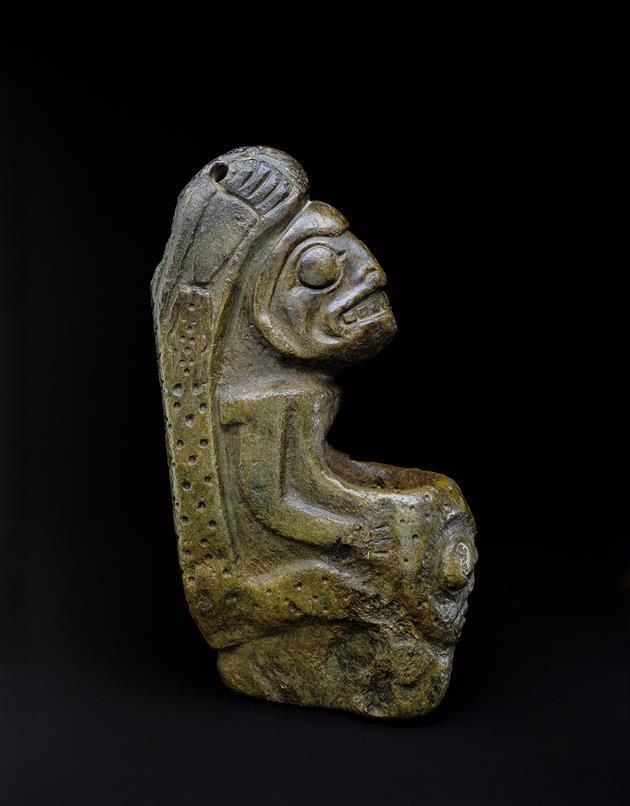
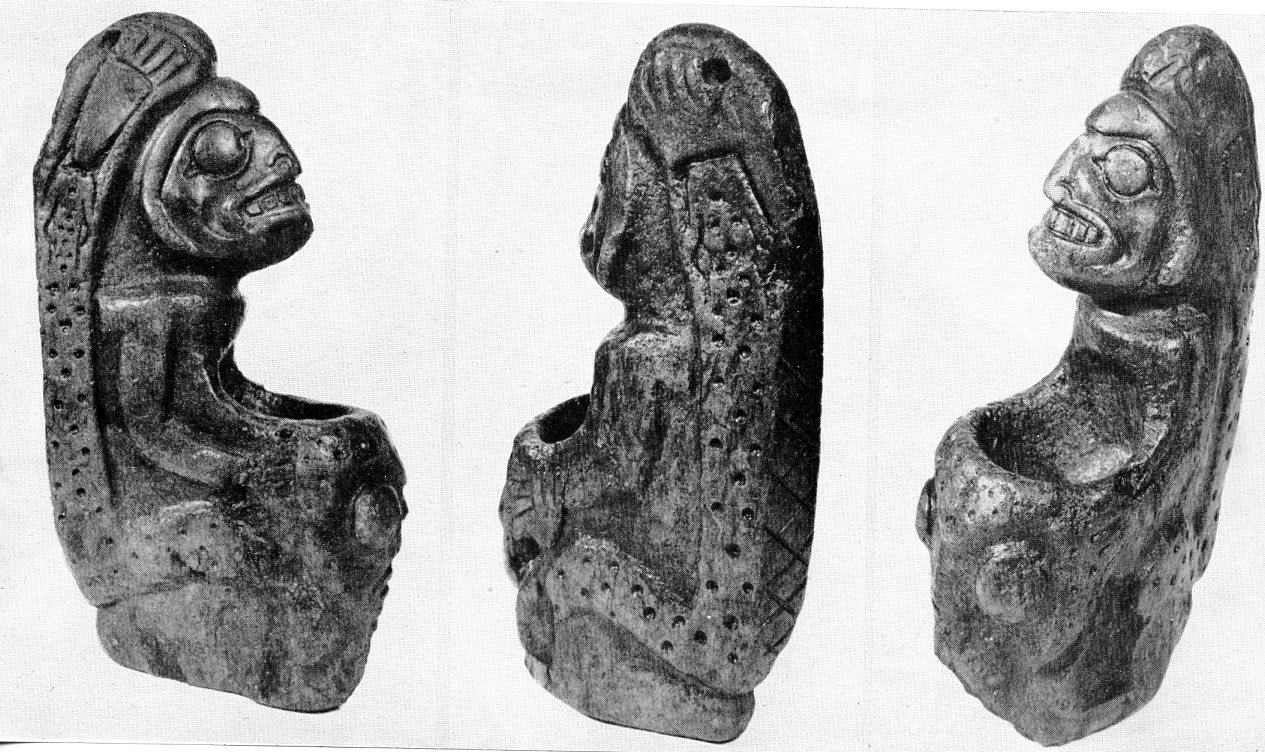
North Saanich Bowl
Now in the Canadian Museum of History (No, VII-G-620). RBCM Borden Number DeRu-Y. This is from one of the Archaeological shellmiddens in Tsehum Harbour (Figure 8). The most likely sites being DcRu-1 or DcRu-4.
Harlan I. Smith Involvement
Harlan I. Smith, in his 1907, publication on the Archaeology of the Gulf of Georgia and Pugel Sound, shows a drawing of the bowl by E.H. Woods, labelled figure 184b (Page 422). He describes this bowl as: “From road cut in shell-heap near North Saanich (Newbigging collection), drawing by Miss E. H. Woods.”. “Fig. 184, b, has both a vertical and horizontal perforation through a small projection at the occiput”. Smith undertook archaeological work in Victoria in 1897, 1898 and 1909.
John Newbigging (1845-March 12, 1933), the person whose collection the bowl came from, was a farmer and mill engineer in north Saanich from 1875-1878. He subsequently had other engineering jobs and moved to Victoria after he married in 1882, and until his death July 15, 1919. It is most likely that his Indigenous artifact collection was acquired during his earlier years near Sidney.
Smith has a drawing of this bowl in his 1923 publication (Plate XVII, fig, 1). Smith (1907:330) notes the context of the bowl as: “There is a shell-heap of considerable extent and height on the peninsula between North Saanich Bay and Canoe Pass. This heap extends across the base of the small point on the western side of this peninsula, and along the beach some distance northward. On the little point were a number of cairns which were explored by us in 1898. Following this beach northward, another shell-heap is found, extending along the shore on the northern side of the small arm of the sea which makes in here, and which ends toward the southwest. This heap is not far from the east-and -west road at this point. Most of Mr. J. Newbigging ‘s collection was found in cutting this road”.
Wilson Duff description
Wilson Duff describes this bowl (see figure 8), based only on Harlan Smith illustrations, in his Prehistoric Stone Sculpture of the Fraser River and Gulf of Georgia (1956:33; Plate 13, fig, A, p. 140):
“The figure is of soapstone, and is about 7 inches high and 6 1/2 inches front to back. It shows a seated figure with arms and legs around a bowl which has an animal-like or bird-like face on the front. The face appears to have a heavy brow. The eyes have oval pupils with regular shaped incised corners. Details of the nose are obscure, but the mouth is protruding and rounded as though singing. Ears project from each side and are perforated. The expanding top knot rises from the flat top of the head.
The neck is short. Short arms slope down the sides of the bowl, ending in four fingers. Partly bent legs with feet extend along the sides as well, and join the hips which may extend around the back. The face on the front of the bowl has a protruding snout or beak and long narrow eyes with round pupils. No other details can be discerned”.
The location of this bowl is wrong in Duff’s later publication, Images Stone B.C. Thirty Centuries of Northwest Coast Sculptures (1975). In the latter, the bowl is listed as: “Seated Human Figure Bowl (Lytton)” on page 28. In the caption on page176 it is noted: Height 7”. National Museum of Man, Ottawa VII-G-620. ‘Probably from Lytton’. The bulky cheeks of this figure represent snakes. From the Bossum collection. Published by Duff, 1956a, p.25, P1. 13a; also M. W. Smith. 1956. P1. Ca.”
During the Stone Images Project Hilary Stewart acquired money to undertake a photographic survey for the project. She was responsible for “photographs, line drawings and other visual material”. I assisted her with some of these activities when at the Royal B.C. Museum. I know she ordered material from the (then) National Museum of Man, but I never saw the results. The illustration, in Duff’s 1975 publication, shows the bowl from the left side. The image shown here (figure 8) is the Canadian Museum of History photograph J-5035, showing the right side of the bowl.
This bowl is mistakenly presented as a different bowl in Hanna (1996). Hanna’s bowl #33, figure 44, listed as “The Bossom Lytton Bowl” is the same as his Bowl #32, Figure 43, “The North Saanich bowl”.
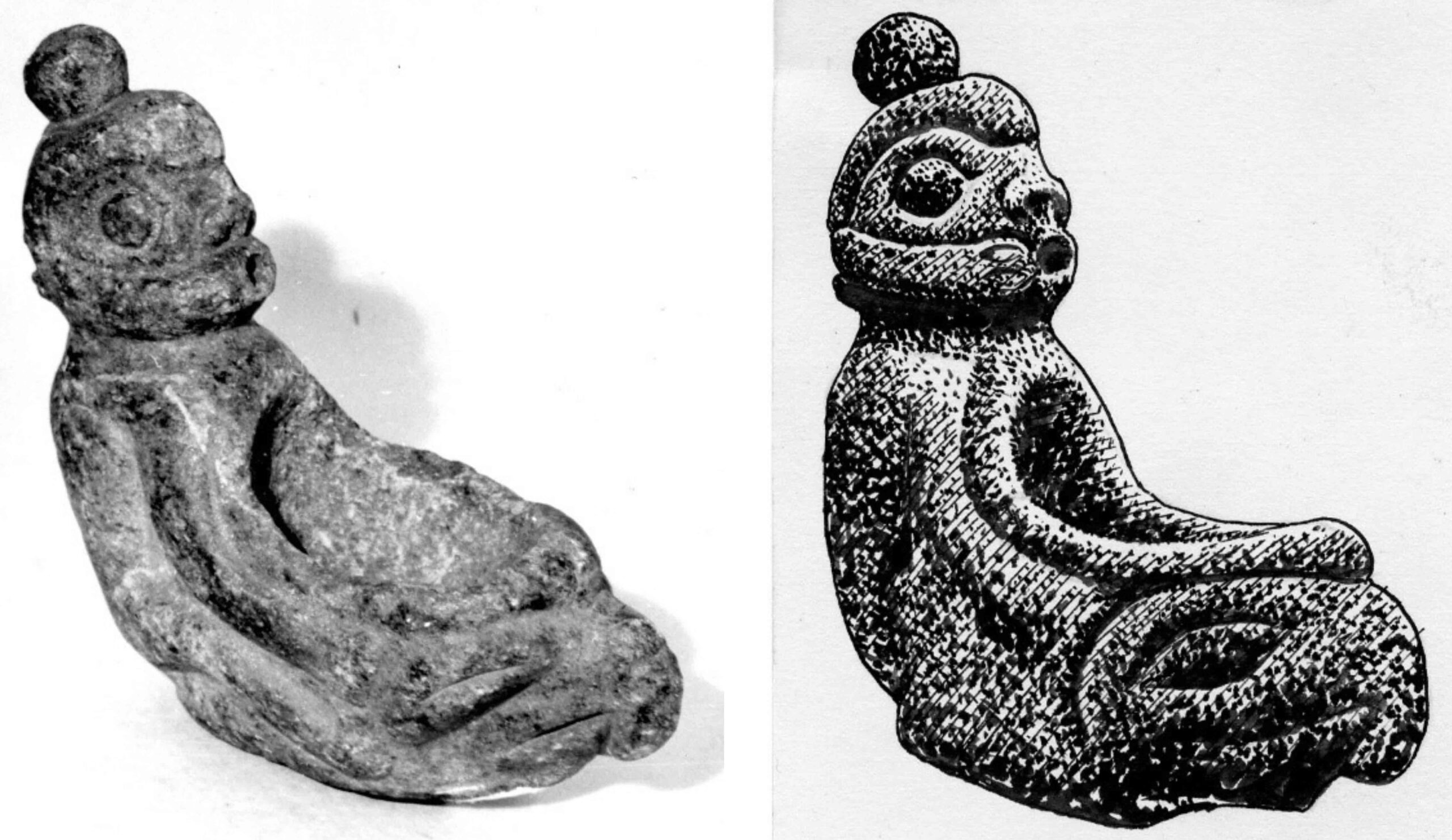
The Chicago Bowl
Now in the Chicago Natural History Museum (No. 79382). There are two casts of this bowl in the RBCM collection. These are given the general area Borden number of DdeRu-Y:77 (Cast). Cast number 1 and cast number 2 (figures 9&10).
History
Harlan I. Smith 1907, fig. 183a. Smith 1923, Pl XVI, fig, 1. The drawing in the latter publication (pl XVI, fig. 1), is given as being after the former publication. Smith notes there is a “Cast. Cat, No. X-11-B-636 in Victoria Memorial Museum, Ottawa, Canada”. Smith notes it is “From Saanich peninsula, southeastern Vancouver Island, B>C.”.
Wilson Duff Description
Wilson Duff describes this bowl (1956:35): “Provenience – According to records in the Chicago Natural History Museum, where this figure is now preserved (N. 79382), it was found in an old shell-mound, Saanich” and was collected in 1902 by Dr. C. F. Newcombe, Several Museums have casts, including the Provincial Museum (No. 1067).
Description – (from casts and illustrations) . The material is said to be soapstone. Height is 10 inches, width 7 inches. Represented is a human figure with arms around a bowl. There is a large flat base, but it is slanted at such an angle that the figure falls backward when set on it (at least the cast does). The head is large, looks upward, and is separated from the body by a distinct neck. A heavy brow ridge crosses the forehead and extending down the sides, extending to the ears, which are pierced. The eyes, defined by incising, are large, roughly round, with corners. The nose is broad, the alae are outlined, and the nostrils are deep drilled holes which do not quite meet to perforate the septum. The thick-lipped mouth is very slightly open. The chin protrudes. On top of the head is a large top-knot,
The back of the head, and the whole figure, is hollowed out slightly, and the concave surface is plain. Definite raised shoulders are present, from which the arms extend in relief down the sloping rim of the bowl and bend forward to the front. No fingers are shown. Shoulder-blades are clearly depicted, also two ribs on the right side. No legs are shown.
Pecked (?) groves on the front of the bowl may be meant to represent a face, but no distinct features can be discerned. The bowl is large, and hollowed into the lap and chest of the figure. It would hold fluid, whether the figure were on its base or lying on its back.”

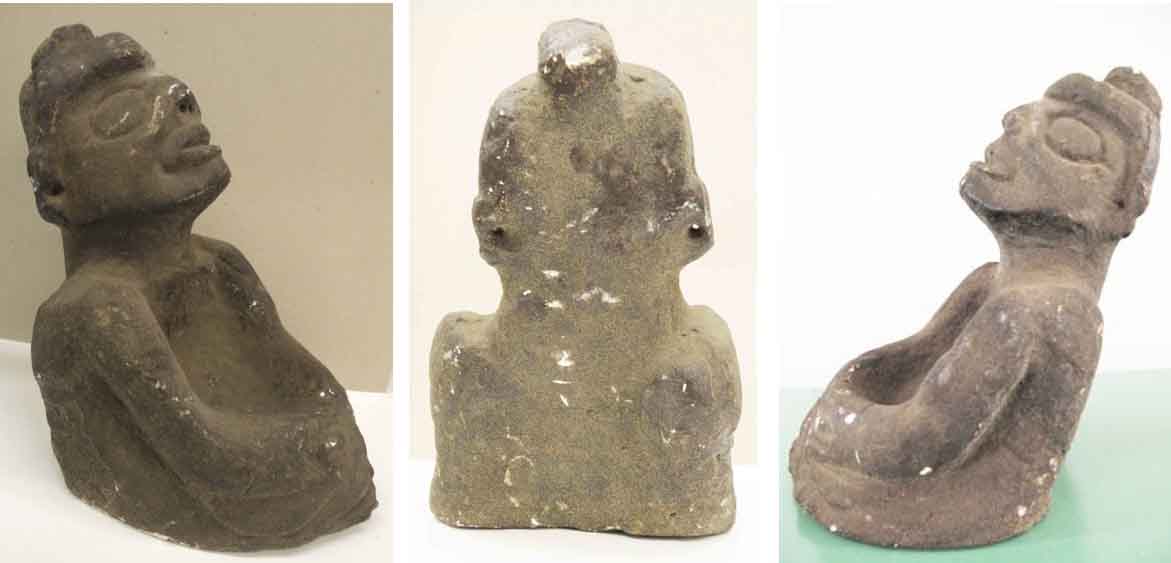
The Bazan Bay Bowl
This bowl is from the Bazan Bay archaeological shellmidden site, DdRu-4, located just south of Sidney on the Saanich Peninsula (Figure 11 & 12).
It was in the private collection of Edith Cross of Saanich, who sold it to U.B.C. I previously confirmed the find location with the late Edith Ross.
Wilson Duff Description
Duff, in his 1975 publication, shows this as his # 33, where the provenience is captioned as “Sidney” (Duff 1975:62). In his 1956 publication he shows it in his plate 11 and describes it in detail:
“It represents a (seated?) human (or bird?) figure, holding a bowl, with prominent faces on both front and back. The head of the figure has broken off. The identity of the main figure is doubtful. It has a neck and shoulders which are typical, but no should-blades, fingers or backbone are shown. The rounded rim of the bowl is slopes downward toward the front, and extending down the sides of the bowl parallel with this rim are incised designs which could be either wings or elaborately costumed arms. The designs consist of three parallel lines with short cross-lines between them. At right angles to these are a number of parallel lines on the sides of the bowls which are somewhat like ribs but appear more like feathers. The bird-like impression given by the main figure is heightened by the shape of the lower part of its back, which flares back like a bird’s tail, and is bifurcated. Again, this could depict human buttocks, but looks more like a bird’s tail. Consequently, the main figure may be a bird, and if it is human, it has bird-like aspects.
Of the two human heads, which stand in relief on the front and back of the bowl, the one on the back is bigger. It has a bulging forehead which is carried as a ridge down the side to ear level, where it has drilled perforations. The eyes have lenticular pupils, and lips with elongated corners. The nose is flat and shapeless, but drilled nostril-holes perforate the septum. The mouth, fairly large, is closed and thick-lipped. The cheeks are fat and chubby, the chin somewhat prominent.
The smaller head on the front of the bowl is also high in relief with a very prominent chin jutting far forward. Its style is similar to the other” brow ridge curing down to ear level where it is perforated, lenticular eyes with lids and elongated corners, flat perforated nose, protruding mouth with thick lips closed. The nose is better formed, its mouth larger, and its chin more prominent than the other face.
Behind each head on the sides of the bowl are what appear to be part bent arms in low relief . The pair of each side touch at the ‘elbows’. However, since these occur in unnatural positions, and no fingers are shown, they may not be meant as arms.” (Duff 1856:36).

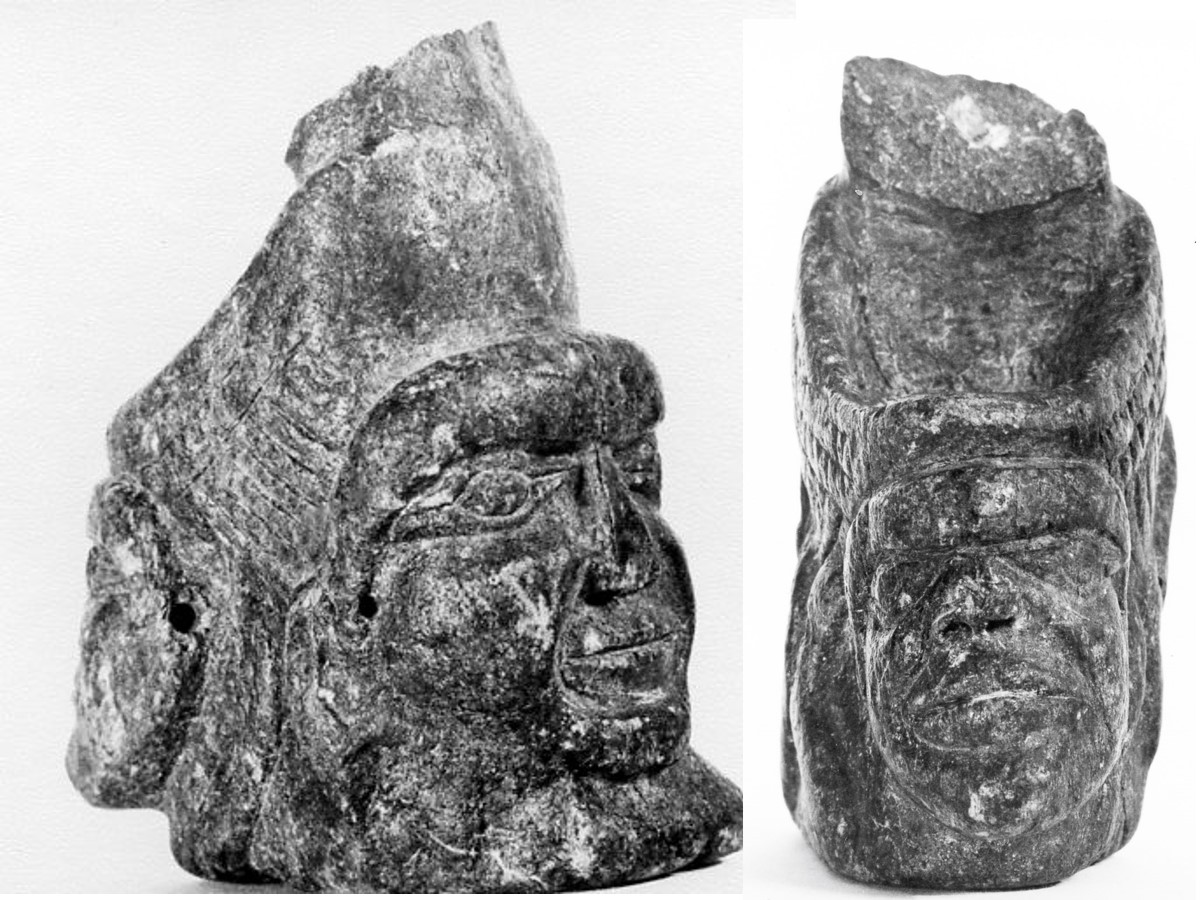
The Saanich Tongue Stone Figure
This figure is in a private collection (Figure 13). I examined this sandstone figure on January 20, 2011. I determined that it was not a modern fake. It appears to be a broken off and weathered front lower portion of a seated human figure bowl, based on the positioning of its fractured surfaces. This figure has large incised oval shaped eyes and a large mouth with a predominant tongue sticking out. A portion of the tongue and the nose have been broken off. The shape of the figure and structure of the breakage is reminiscent of stone bowls that have a lower portion of the bowl with a human face in front of the bowl, as opposed to the face of the main figure of the bowl.
The maximum height of the figure is 190mm. It is 146mm wide across the top of the head., 106mm between the jowl cuts on the face; 44mm between the eyes and each eye is 44mm wide.
The figure was given to the owner by her father who received it from his sister. The location of the find was not passed on, but it was believed to be from Saanich. Theh previous owners lived on the Saanich peninsula most of their lives. The owner’s aunt lived on Treetop Lane which is on a high area that rises above Cadboro Bay road on the west and forms a high bluff with Cordova Bay on the east side. A few older style projectile points have been found near the east high point of this road in the past. This iniducates some use of the area in the area, but there are no formally recorded archaeological sites in this high location. The stone figure fits in with the general characteristics of stone bowls from the larger region. It is most likely that this stone head came from one of the larger archaeological shell midden sites along Cordova Bay Road, but we cannot rule out that it came from an isolated location. I am calling it the Saanich tongue bowl because of the prominence of the tongue and for the convenience of giving it a name. The lack of detail may suggest that the figure was broken during its manufacture.
